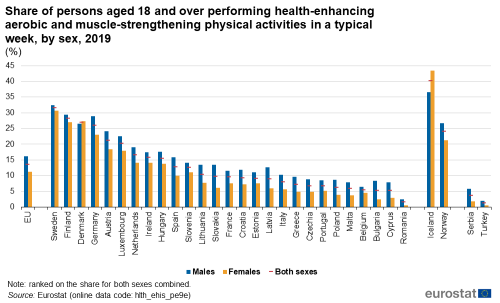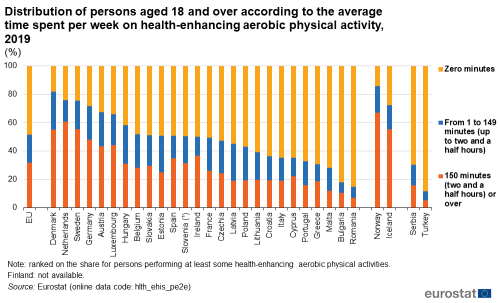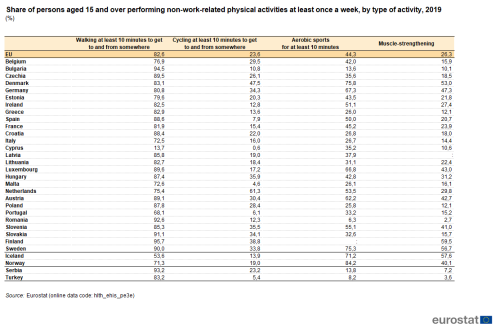The third wave of the European health interview survey (EHIS) was conducted in 2019 and surveyed persons aged 15 and over. It included questions for the evaluation of different aspects in the lifestyles of Europeans having an impact on their state of health, which among others, captured non-work-related physical activity. The latter includes activities such as reflecting the way that people usually get to and from somewhere in a typical week, for example walking or cycling for at least 10 minutes in order to get to and from work, school, shopping or markets. It also includes leisure-time physical activities that persons engage in for at least 10 minutes continuously throughout a typical week. These cover sports, fitness and recreational activities that cause at least a small increase in breath or heart rate. Muscle-strengthening activities, such as resistance training or strength exercises, are also considered.
Over four fifths of the EU population reported walking to get to and from places at least once a week
With regard to physically active transportation, 82.6 % of people aged 15 and over in the EU spent at least 10 minutes continuously walking to get to and from somewhere on at least one day within a typical week in 2019 (Table 1). This share was relatively high across the majority of the EU Member States, generally ranging from 68.1 % in Portugal to 95.7 % in Finland. One exception was Cyprus, where the share was 13.7 %. Nearly one quarter (23.6 %) of the reference population in the EU cycled to or from somewhere at least once a week in 2019. This activity was most common in the Netherlands and Denmark, performed by 61.3 % and 47.5 % of the reference population respectively. Elsewhere the share was less than two fifths, dropping below 10.0 % in Spain, Portugal and Malta, and below 1.0 % in Cyprus. It should be noted that climatic conditions in various seasons may strongly influence this activity.
In 2019, 44.3 % of people aged 15 and over in the EU reported participating for at least 10 minutes in aerobic sports at least once a week. Among the EU Member States, this share ranged from less than 10.0 % in Romania to 75.3 % and 75.8 % in Sweden and Denmark; the share was also below 10.0 % in Turkey and reached 84.2 % in Norway. The same Member States were also at the top and bottom of the ranking in terms of the share of the population undertaking muscle-strengthening activities: 2.7 % in Romania and over 50.0 % in Denmark and Sweden, as well as in Finland; again, the share was also low in Turkey (3.6 %), while it was high in Iceland (57.6 %).
(%)
Source: Eurostat (hlth_ehis_pe3e)
Health-enhancing physical activity
Physical activity benefits health and functional capacity. The World Health Organization recommends for adults a minimum level of two and a half hours of moderate-intensity aerobic physical activity per week, which should be performed in bouts of at least 10 minutes duration. It also suggests that muscle-strengthening activities involving major muscle groups should be done at a frequency of two or more days per week. In response to WHO recommendations, the third wave of the EHIS provides data on the performance of both aerobic and muscle-strengthening physical activities.
The highest shares of the population performing health-enhancing aerobic and muscle-strengthening physical activities were observed in the Nordic Member States
Figure 1 focuses on the share of the adult population (persons aged 18 and over) who performed both aerobic physical activities of moderate intensity for at least two and a half hours per week as well as muscle-strengthening activities for at least two days per week. Among adults in the EU, the share of those preforming both aerobic and muscle-strengthening activities in line with the recommendations was 13.6 % in 2019. In a small majority of the EU Member States, this share accounted for less than 10.0 % of the reference population. Shares above 20.0 % were observed in Luxembourg and Austria, and above 25.0 % in Germany and the three Nordic Member States – Denmark, Finland and Sweden; high shares were also recorded in Norway and particularly Iceland. By contrast, 1.5 % of the reference population in Romania performed the recommended amount of physical activity; low shares were also observed in Turkey and Serbia.

(%)
Source: Eurostat (hlth_ehis_pe9e)
The gap between men and women meeting the recommended levels of aerobic and muscle-strengthening physical activities was 4.8 percentage points in the EU
An analysis by sex indicates that a higher share of men than women in the EU performed both aerobic and muscle-strengthening activities to the recommended minimum levels of activity in 2019: 16.1 % for men compared with 11.3 % for women – see Figure 1. A gender gap with a higher share for men was observed in nearly all EU Member States, with the largest gaps in Slovakia (7.4 percentage points) and Latvia (6.7 percentage points). Denmark was the only exception among the Member States, as the share for women was 0.8 percentage points higher than for men; among the non-member countries shown in Figure 1, Iceland also had a higher share for women, with a gender gap of 6.9 percentage points.
The share of people performing the recommended aerobic and muscle-strengthening physical activity levels decreased with increasing age
Age is an important factor in terms of the likelihood of adults spending the recommended amount of time on exercise: the share of people at least meeting the recommendations decreases with age (see Table 2). In the EU, over a quarter (26.9 %) of people aged 18–24 years and over one fifth (20.5 %) of people aged 25–34 years performed the recommend physical activities in a typical week in 2019. This share fell progressively through the age groups 35–44, 45–54 and 55–64 years and was 7.4 % in the oldest age group, among people aged 65 years and over.

(%)
Source: Eurostat (hlth_ehis_pe9e)
This pattern of a decreasing share of people spending the recommended amount of time on exercise for progressively older age groups was observed in 2019 across almost all EU Member States. Denmark was the most notable exception in that a higher share of people aged 65 years and over met the recommendations than was the case for those aged 25–34 or 55–64 years. Other differences were observed in France, Luxembourg and Austria, where the share for the age group 45–54 years was lower than that for the age group 55–64 years. Among the non-member countries shown in Table 2 there were also some small differences, such as a relatively low share for persons aged 25–34 years in Iceland, or 18–24 years in Turkey.
Comparing EU Member States within specific age groups, there are clear differences in the likelihood of people performing aerobic and muscle-strengthening physical activities. Among the youngest age group (aged 18–24 years), the share of persons reporting that they performed at least the recommended activity levels exceeded one third in Austria and Denmark and exceeded two fifths in Sweden, Finland and Germany (45.8 %); higher shares were observed for this age group in Norway (46.1 %) and Iceland (63.0 %). These five Member States as well as Luxembourg reported that at least one tenth of people aged 65 years and over also performed at least the recommended activity levels, with this share peaking at 25.2 % in Sweden; high shares for this age group were also observed in Norway and Iceland.
Close to one third of people in the EU aged 18 years and over engaged in aerobic physical activities for at least two and a half hours per week
Focusing upon aerobic physical activities only, almost half (48.4 %) of the EU population aged 18 years and over did not undertake any such activities at all in a typical week in 2019 – see Figure 2. In 13 of the EU Member States, the share of persons who did not spend any leisure time performing such activities exceeded 50.0 %. This share varied from less than 25 % in Denmark, the Netherlands and Sweden, to more than 80.0 % in Bulgaria and Romania.
Turning to people who performed aerobic physical activities for at least two and a half hours (150 minutes or more) a week, their share in the EU was 31.7 % in 2019. Among the EU Member States, the lowest share – less than one tenth – was observed in Romania (7.1 %); an even lower share (5.0 %) was observed in Turkey. By contrast, in three Member States this share exceeded a half: Denmark (54.9 %), Sweden (55.5 %) and the Netherlands (60.8 %); this was also the case in Iceland (55.3 %) and Norway (67.2 %).

(%)
Source: Eurostat (hlth_ehis_pe2e)
The percentage of Europeans meeting the weekly recommended level of aerobic physical activity was higher for higher levels of educational attainment
Overall in the EU, 42.4 % of people with a high level of education (a tertiary level) spent at least two and a half hours per week on aerobic physical activities in 2019, as compared with 32.8 % of those with a medium level (upper secondary or post-secondary non-tertiary level) and around one fifth (20.5 %) for those with a low level of educational attainment (at most, lower secondary level) – see Figure 3.

(%)
Source: Eurostat (hlth_ehis_pe2e)
The pattern observed for the EU as a whole was repeated in the vast majority of the EU Member States. The difference in the shares recorded for people with high and low levels of education was 21.9 percentage points in 2019 in the EU. Among the Member States, the largest differences were in Greece, Slovakia, Austria and Ireland; there was also a large difference in Iceland.
Around two fifths of the adult population in the EU in the highest income quintile engaged in aerobic physical activities for at least two and a half hours per week
Income is another factor that may be linked to the likelihood of performing aerobic physical activity. The share of adults performing aerobic physical exercise for at least two and a half hours per week was higher for higher income levels – see Figure 4. In 2019, 39.5 % of the EU population in the fifth/highest income quintile (the 20 % of the population with the highest income) reported spending the recommended amount of time exercising per week, compared with 31.2 % in the third income quintile and 26.3 % in the first/lowest income quintile (the 20 % of the population with the lowest income).

(%)
Source: Eurostat (hlth_ehis_pe2i)
Nearly all of the EU Member States reported a similar pattern to that observed for the EU. Among the non-member countries shown in Figure 4, Iceland was also an exception, as the share for the first/lowest income quintile was somewhat higher than that for the middle income quintile.
The difference in the shares recorded for people with high and low income levels was 13.2 percentage points in 2019 across the EU. Among the EU Member States, the largest difference was observed in Ireland. The narrowest differences were in Romania (where low shares were observed for all income levels).
Source data for tables and graphs
Data sources
The third wave of the European health interview survey (EHIS) is the source of information for the data presented in this article. The general coverage of the EHIS is the population aged 15 years and over living in private households residing in the national territory. This source is documented in more detail in this background article which provides information on the scope of the data, its legal basis, the methodology employed, as well as related concepts and definitions. Note that the population covered when analysing health-enhancing aerobic and muscle-strengthening physical activities concerns adults aged 18 years and over.
The third wave of the EHIS was conducted in all 27 EU Member States, as well as in Iceland, Norway, Serbia and Turkey. The data collection period was generally 2019. However, it was 2018 for Belgium, 2018–2019 for Austria, and 2019–2020 for Germany and Malta.
The indicators presented in the article focus on the frequency and amount of leisure-time physical activities performed within a typical week. They aim to provide a useful insight for the measurement of the effect of physical activity on health status within the EU population.
The data on non-work-related physical activity cover activities such as aerobic sports, cycling and walking to get to and from places, and muscle-strengthening activities undertaken at least once a week.
Under health-enhancing physical activities, sports (including aerobic sports, as well as cycling as a form of transportation) and muscle-strengthening activities are included. The respective indicator aims to respond to the minimum level of non-work-related physical activity recommended by the WHO.
Aerobic sports, as well as walking and cycling, are considered if having at least 10 minutes continuous duration. Muscle-strengthening activities are not the same as aerobic activities such as running, swimming or cycling, since they are usually performed in sets of repetitions, rather than continuously.
Limitations of the data
The indicators presented in this article are derived from self-reported data. Therefore, they are to a certain extent affected by respondents’ subjective perception as well as by their social and cultural background.
Context
As a social behaviour, the extent of physical activity in the everyday lives of European citizens depends on a range of diverse factors such as the availability of leisure time, access to activity spaces, cultural factors, as well as the socioeconomic profile of specific societal groups. On the other hand, there is a general consensus on the positive effects that physical activity may have on health status and indirectly on public health costs, as well as the overall benefits for the economy of a healthy workforce. For these reasons, governments may introduce policies to promote physical activity habits in education, as well as among the general population, through health campaigns, by investing in and ensuring the availability of public spaces for physical activity, and also by monitoring those factors that may prove an obstacle to physical activity, such as work intensity and a lack of leisure time.
To this end, in 2008, the European Commission published the EU Guidelines for the development and implementation of cross-sectoral policies in support of health-enhancing physical activity (HEPA). Within this context, the guidelines set a number of policy areas for action, such as sport, transport, education, urban planning, public safety, working environment and senior citizens.
Based on the proposal of the European Commission, the Council adopted its first Recommendation on ‘Promoting health-enhancing physical activity across sectors’ (2013/C 354/01) in 2013. The Recommendation encourages EU Member States to adopt cross-sectoral policy approaches and action plans for the promotion of physical activity and enhances policy coordination among them. It establishes a framework for monitoring the progress of HEPA through a set of 23 indicators covering different relevant thematic areas. In response to the Council’s request for reporting progress on the implementation of the Recommendation every three years, the European Commission issued a report on the ‘Implementation of the Council Recommendation on promoting health-enhancing physical activity across sectors’ in 2016. Based on the contributions of the Member States, the progress report elaborates on problems encountered and suggestions related to the implementation of the HEPA framework.
In addition, the World Health Organisation makes recommendations for children, adults and older people separately concerning the frequency, duration, intensity, type and amount of the required physical activity for the prevention of non-communicable diseases. More specifically, it recommends for adults at least 150 minutes of moderate-intensity aerobic physical activity weekly or at least 75 minutes of vigorous-intensity aerobic activity or an equivalent combination of moderate and vigorous-intensity activity. It also suggests that muscle-strengthening activities should be done for major groups at a frequency of two or more days per week.
An indicator linked to WHO HEPA recommendations about the population fulfilling the WHO recommendation on aerobic and muscle-strengthening physical activity is included in the determinants of health chapter of the European core health indicators (ECHI).

